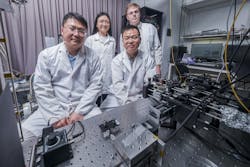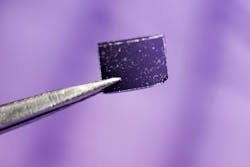Photonics breakthrough can drastically shrink quantum computing parts
Many quantum computers use electrons as small switches called quantum bits, or qubits, to perform numerous calculations simultaneously. By using quantum computers, we could resolve complicated calculations within minutes instead of millions of years, which today’s supercomputers would need.
The benefits of such high-speed computing are staggering. We could discover new drugs much faster, for example, and better understand the complexities of climate change by harnessing the ability of quantum computers to perform calculations and discover patterns within large data sets quickly.
But there is a challenge: For electron qubits in quantum computing to work, they require ultracold temperatures close to the coldness of outer space.
An alternative is to use light particles, or photons, which can function as qubits at room temperature—they could be cheaper, simpler, and more practical than using electrons. For photons to become qubits, the light particles must be produced in linked or entangled pairs so that what happens to one photon affects the other instantly, no matter how far apart they are.
A crucial requirement for entanglement is that photon pairs must vibrate in sync. One way to do this is to shine a laser on millimeter-thick crystals and use optical equipment to maintain the link between the photons. But such a setup is too big to integrate into a computer chip, which limits its usefulness.
Our team at Nanyang Technological University, Singapore (NTU Singapore), led by Professor Weibo Gao, found a way to address this issue by using much thinner materials that are micrometers thick.
This could shrink quantum computing parts by 1,000x and make devices for quantum applications—such as quantum information and photonic quantum computing—more compact and simpler by eliminating the need for bulky optical gear.
The quest for thinner materials
Scientists have sought thinner materials to generate photons as qubits, but this is difficult because when materials get thinner their photon production rate falls, which makes them impractical for quantum computing.
But scientific advances in recent years found a crystalline material called niobium oxide dichloride (NbOCl2) that holds promise. The material has unique optical and electronic properties and can produce photon pairs efficiently, even though it is merely micrometers thick. One major problem is the photons it generates are still not entangled and cannot be used as qubits.
We discovered a way to tackle this.
Inspiration from the past
Gao, from NTU Singapore’s School of Electrical & Electronic Engineering and School of Physical & Mathematical Sciences, theorized that an established method to produce linked photon pairs with larger crystalline materials could be applied to thinner NbOCl2.
The existing method, published in 1999, stacks two flakes of thick crystals together. The crystalline grains of each flake are aligned perpendicularly to each other before a laser is shone at the crystals.
But the photon pairs produced in this way can still vibrate out of sync because of the way they travel inside the bulky crystals. As a result, optical equipment is needed to synchronize the light particles to ensure they become entangled. Aligning the optical gear to do this can also get cumbersome.
If niobium oxide dichloride flakes are used instead, Gao believed the photons created would travel a shorter distance inside the thin flakes because they are much thinner than the bulkier crystals from past research. This would cause the photons generated within the thin flakes to become synchronized and entangled—without using extra optical equipment to ensure the photons were linked.
In collaboration with Professor Liu Zheng from NTU Singapore’s School of Materials Science & Engineering, our team conducted experiments to check this. We used NbOCl2 flakes with a combined thickness of 1.2 µm, or about 80x thinner than a strand of hair.
Results of our experiments support Gao’s hypothesis, and the photon pairs produced show an 86% resemblance to ideally entangled photons. This suggests our method is a reliable way for producing qubits for quantum computing.
The novel method “is a major advancement, potentially enabling the miniaturization and integration of quantum technologies,” says Professor Zhipei Sun from Finland’s Aalto University, who specializes in photonics and was not involved in NTU Singapore’s research. Sun is a co-principal investigator at the Research Council of Finland’s Center of Excellence in Quantum Technology. “This development has potential to advance quantum computing and secure communication, because it allows for more compact, scalable, and efficient quantum systems,” he adds.
We are now planning to optimize our setup to improve its photon generation output, which will involve studying whether introducing tiny patterns and grooves on the NbOCl2 flakes’ surface could boost the creation of linked photon pairs. We are also exploring whether photon production can be improved by stacking other materials with the NbOCl2 flakes.
FURTHER READING
L. Kallioniemi et al., Nat. Photon. (Oct. 2024); https://doi.org/10.1038/s41566-024-01545-5.
About the Author
Leevi Kallioniemi
Leevi Kallioniemi is a Ph.D. student at Nanyang Technological University in Singapore.
Xiaodan Lyu
Xiaodan Lyu is a research fellow at Nanyang Technological University in Singapore.




